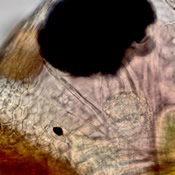| Ecology and Behavior | |||||||||||||||
| Characteristics | |||||||||||||||
|
|||||||||||||||
| Similar Species | |||||||||||||||
| Immature D. pulex form "neckteeth" induced by chemicals (kairomones) released by Chaoborus (1). D. pulex resembles D. middendorfiana in Arctic and alpline ponds. However, D. pulex lacks morphological structures for defense against invertebrate predators, such as a long tail spine and hard carapace (2). D. middendorfiana often has a lower reproductive rate than D. pulex, which is attributed to the high energetic cost of producing these morphological defenses (2). D. pulex is easily confused with D. pulicaria (9). | |||||||||||||||
| Geographic Distribution | |||||||||||||||
| D. pulex is ubiquitous and is reported throughout North and South America, Europe and Australia. | |||||||||||||||
| Reported Habitats | |||||||||||||||
|
D. pulex is characteristically associated with small ponds, although less pigmented populations of D. pulex may occur in deep, clear lakes, such as Lake Titicaca (Haney, pers comm.).
Daphnia pulex has a broad range of habitats. It is the most common Daphnia found in ephemeral pools, but it also occurs in lakes ranging from ultra oligotrophic (clear bodied with little pigmentation) to eutrophic, where they may be bright red because of high hemoglobin production. Forms of D. pulex in large lakes may be difficult to distinguish from D. pulicaria. |
|||||||||||||||
| Food and Feeding Behavior | |||||||||||||||
| D. pulex has been widely used in zooplankton feeding studies. Results indicate great variability between populations from different lakes, such as their ability to resist cyanobacteria toxins (3). The presence of Microcystis aeruginosa induced ephippia production in D. pulex in the laboratory (3). |
|||||||||||||||
| Predation on Daphnia | |||||||||||||||
| Immature stages of copepods may enter the brood pouch of various Daphnia species, including D. pulex, where they consume the daphnid eggs (3)(4)(5). Clones of D. pulex with a longer secondary abdominal process are better protected from brood pouch predation by adult Eucyclops agilis, thus protecting their eggs (6). | |||||||||||||||
| Competition | |||||||||||||||
| D. pulex consistently suppressed populations of Brachionus calyciflorus and Keratella cochlearis in competition experiments in the lab. This was due to the superior feeding efficiency of Daphnia. However, D. pulex also can have direct ”interference competition” effects on K. cochlearis by drawing the rotifer into the filtering chamber in the feeding currents and then rejecting the damaged rotifers (7). Interestingly, the more agile rotifer Polyarthra, can detect these filtering currents and escape by quick lateral swimming motion (7). | |||||||||||||||
| Additional Pictures | |||||||||||||||
|
|||||||||||||||
| References | |||||||||||||||
|
(1) SCHWARTZ, S. S., D. J. INNES, AND P. D. HEBERT. 1985. Morphological separation of Daphnia pulex and Daphnia obtusa in North America. Limnol. Oceanogr. 30: 189-197. (2) DODSON, S. I. 1984. Predation of Heterocope septentrionalis on two species of Daphnia: Morphological defenses and their cost. Ecology. 65: 1249-1257. (3) GLIWICZ, Z. M. 1994. Retarded growth of cladoceran zooplankton in the presence of copepod predation. Oecologia. 97: 458-461. (4) GLIWICZ, Z. M. AND H. STIBOR. 1993. Egg predation by copepods in Daphnia brood cavities. Oecologia. 95: 295-298. (5) GLIWICZ, Z. M., AND W. LAMPERT. 1994. Clutch-size variability in Daphnia: Body-size related effects of egg predation by cyclopoid copepods. Limnol. Oceanogr. 39: 479-485. (6) LAURÉN-MÄÄTTÄ, C., J. HIETALA, AND M. WALLSS. 1997. Responses of Daphnia pulex populations to toxic cyanobacteria. Freshwater Biol. 37: 635-647. (7) HEBERT, P. D. N., R. D. WARD, AND L. J. WEIDER. 1988. Clonal-diversity patterns and breeding-system variation in Daphnia pulex, asexual-sexual complex. Evolution. 42:147-159. (8) HALL, D. J., AND G. G. WATERMAN. 1967. Zooplankton of the Finger Lakes. Limnol. Oceanogr. 12: 542-544. (9) Hebert, P.D.N., The Daphnia of North America - an illustrated fauna, CD-ROM, Sept., 1995. |











